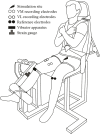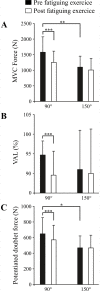Acute effect of tendon vibration applied during isometric contraction at two knee angles on maximal knee extension force production
- PMID: 33186411
- PMCID: PMC7665630
- DOI: 10.1371/journal.pone.0242324
Acute effect of tendon vibration applied during isometric contraction at two knee angles on maximal knee extension force production
Abstract
The aim of the current study was to investigate the effect of a single session of prolonged tendon vibration combined with low submaximal isometric contraction on maximal motor performance. Thirty-two young sedentary adults were assigned into two groups that differed based on the knee angle tested: 90° or 150° (180° = full knee extension). Participants performed two fatigue-inducing exercise protocols: one with three 10 min submaximal (10% of maximal voluntary contraction) knee extensor contractions and patellar tendon vibration (80 Hz) another with submaximal knee extensor contractions only. Before and after each fatigue protocol, maximal voluntary isometric contractions (MVC), voluntary activation level (assessed by the twitch interpolation technique), peak-to-peak amplitude of maximum compound action potentials of vastus medialis and vastus lateralis (assessed by electromyography with the use of electrical nerve stimulation), peak twitch amplitude and peak doublet force were measured. The knee extensor fatigue was significantly (P<0.05) greater in the 90° knee angle group (-20.6% MVC force, P<0.05) than the 150° knee angle group (-8.3% MVC force, P = 0.062). Both peripheral and central alterations could explain the reduction in MVC force at 90° knee angle. However, tendon vibration added to isometric contraction did not exacerbate the reduction in MVC force. These results clearly demonstrate that acute infrapatellar tendon vibration using a commercial apparatus operating at optimal conditions (i.e. contracted and stretched muscle) does not appear to induce knee extensor neuromuscular fatigue in young sedentary subjects.
Conflict of interest statement
The authors have declared that no competing interests exist.
Figures



Similar articles
-
Effects of prolonged patellar tendon vibration on force steadiness in quadriceps femoris during force-matching task.Exp Brain Res. 2016 Jan;234(1):209-17. doi: 10.1007/s00221-015-4447-x. Epub 2015 Sep 29. Exp Brain Res. 2016. PMID: 26419664
-
Effect of knee joint angle on vastus medialis and vastus lateralis rigidity during isometric submaximal voluntary knee extensions.J Electromyogr Kinesiol. 2023 Dec;73:102826. doi: 10.1016/j.jelekin.2023.102826. Epub 2023 Sep 21. J Electromyogr Kinesiol. 2023. PMID: 37774557
-
Short-term effects of whole-body vibration on maximal voluntary isometric knee extensor force and rate of force rise.Eur J Appl Physiol. 2003 Jan;88(4-5):472-5. doi: 10.1007/s00421-002-0723-0. Epub 2002 Nov 9. Eur J Appl Physiol. 2003. PMID: 12527980
-
Is the Focal Muscle Vibration an Effective Motor Conditioning Intervention? A Systematic Review.J Funct Morphol Kinesiol. 2021 Apr 28;6(2):39. doi: 10.3390/jfmk6020039. J Funct Morphol Kinesiol. 2021. PMID: 33924916 Free PMC article. Review.
-
The use of non-linear tools to analyze the variability of force production as an index of fatigue: A systematic review.Front Physiol. 2022 Dec 14;13:1074652. doi: 10.3389/fphys.2022.1074652. eCollection 2022. Front Physiol. 2022. PMID: 36589460 Free PMC article.
Cited by
-
Effect of muscle length on maximum evoked torque, discomfort, contraction fatigue, and strength adaptations during electrical stimulation in adult populations: A systematic review.PLoS One. 2024 Jun 10;19(6):e0304205. doi: 10.1371/journal.pone.0304205. eCollection 2024. PLoS One. 2024. PMID: 38857245 Free PMC article.
-
Hip and Knee Joint Angles Determine Fatigue Onset during Quadriceps Neuromuscular Electrical Stimulation.Appl Bionics Biomech. 2022 Jul 22;2022:4612867. doi: 10.1155/2022/4612867. eCollection 2022. Appl Bionics Biomech. 2022. PMID: 35937098 Free PMC article.
References
Publication types
MeSH terms
LinkOut - more resources
Full Text Sources

